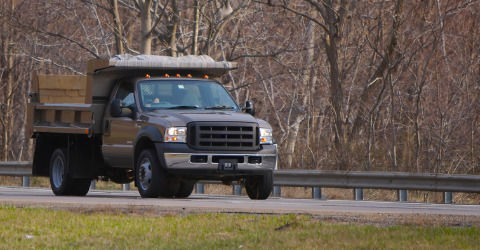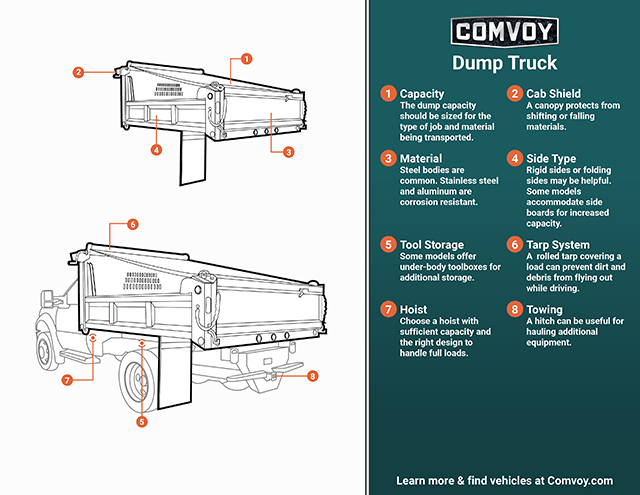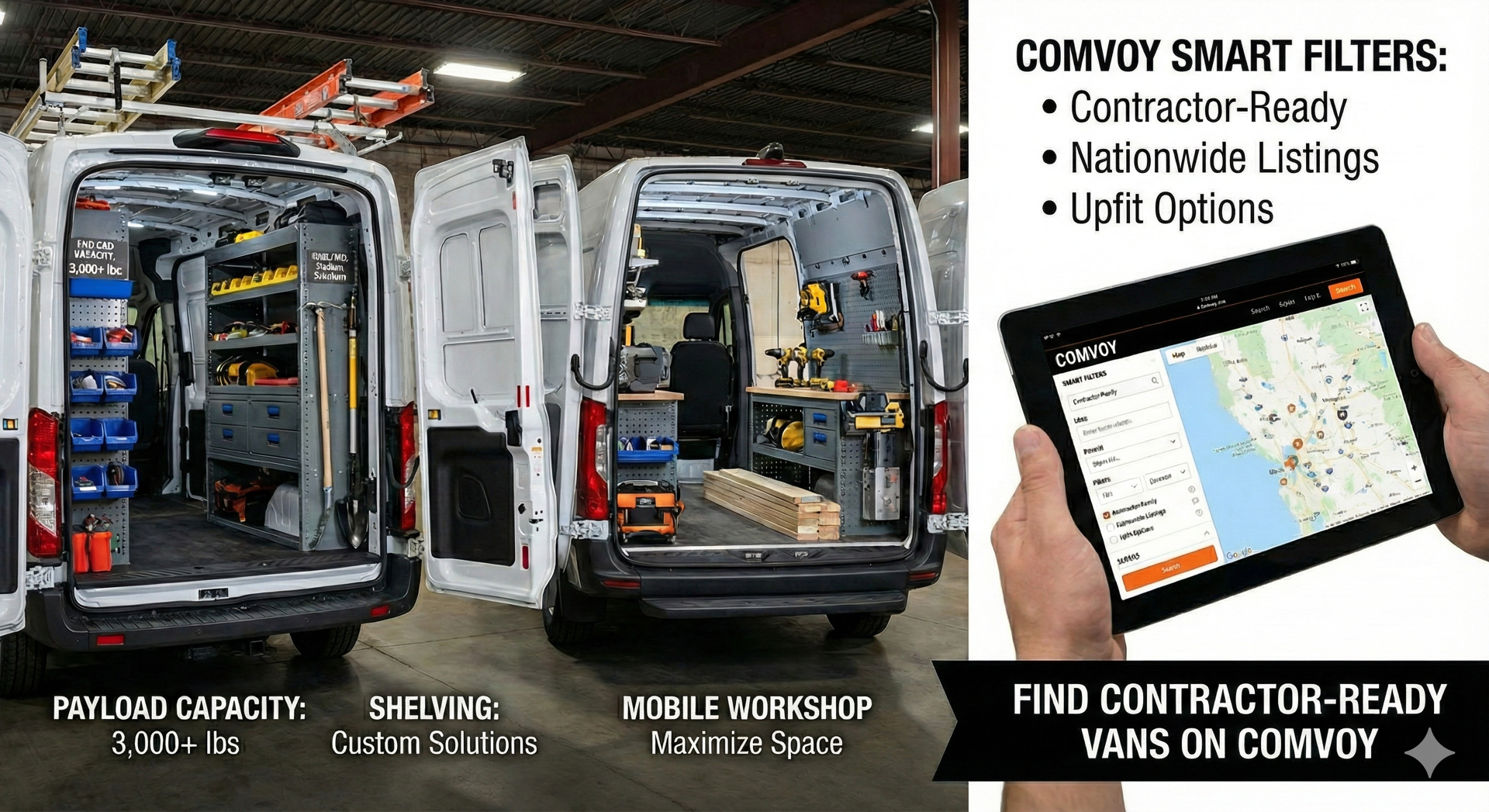Dump Truck: Hauling and Delivering
 (1).png)
 (1).png)
Dump Truck: Hauling and Delivering
The dump truck is a classic commercial vehicle, with a long-standing reputation for good reason. Ideal for hauling and delivering heavy loads of loam, mulch, gravel, rip-rap, asphalt, logs, and heavy stone, the dump truck is the optimal choice for any fleet that deals with loose materials on a consistent basis.
Dump Truck Capacity
The amount of material your dump truck needs to haul, from both a weight perspective and an overall measurement perspective, should be the first stop in any buyer’s purchase process. Dump trucks vary greatly in body sizes and useful interior yardage. Body sizes typically range from two to eight yards, but larger mid- and full-size models can support up to thirty-three yards or more. When considering the size of the body you’ll be supporting, it’s also prudent to identify the weight per cubic yard, for each material of your choosing. Each manufacturer model will vary in its payload capacity and dimensions, making it a prudent step to first identify the size and weight of each load that you plan to deliver, before visiting the dealer.
Dump Truck Cab Shield

A cab shield is an extended metal covering which sits just behind the rear windshield, safeguarding your cab against materials moving about in the cargo bay. Some cab shields also include roof coverage, with two joined pieces of metal fully covering both the roof and rear windshield, featuring a grated mesh behind the rear windshield for improving visibility. The cab shield is built from the same material selected for your dump truck body and serves as a barrier between the dump truck cab and your material. The cab shield is a simple countermeasure to hard stops, traffic accidents, and shifting materials—all of which can result in injured employees and a damaged vehicle.
“If you're hauling rip-rap, asphalt, or demo material, skipping the cab shield is the fastest way to a busted rear window. I’ve seen it more times than I can count.”
—Leyhan Hansen, Founder of the Upfit Insider
Dump Body Material
The dump trucks of yesteryear were predominantly built with steel. Steel was, and still is, a common material used in the production of dump bodies due to its strength and cost-effectiveness. That being said, steel dump bodies also add a fair amount of weight, resulting in an overall reduction in payload capacity before any working materials have been added.
Aluminum alloys, one of the previously questionable options in terms of dump truck body durability, have since achieved high regard in commercial vehicle manufacturing. With modern enhancements like heat treatment, aluminum alloys now boast comparable strength to steel, while also offering the reduced weight that aluminum provides—the lighter weight results in better fuel economy and increased payload capacity. Aluminum alloys also offer better corrosion resistance than steel, making it ideal for corrosion-prone jobs like mulch or asphalt, where steel bodies rot out faster.
Click Here for More Information
Dump Truck Side Type
When using a dump truck, there are often times when the desired function of the truck will change. One workday may require a rigid delivery of loose material into one location from the back of the body, where others may require the ability to dump material off to the side of the dump truck. Fortunately, both rigid-side and drop-side dump bodies are available in the modern dump truck.
A rigid-side dump body is perfect for operation that seldom changes. You can load up the materials, drive off, and unload without the worry of securing drop-side metal panels. Capable of supporting additional side-panels for greater side height, the rigid-side dump body - though restricted in form - is flexible in function. On the other hand, the ability to change the function of your truck as needed is an incredibly powerful feature of the drop-side or fold-side dump truck body. The drop-side dump truck comes with a series of metal side panels, which lock into place and can be dropped down for easy access to either side of the dump truck bed.
Tool Storage On Dump Trucks
Specific dump truck models support side, underbody, and rear-cab toolbox installations, providing secure tool storage without skimping on valuable cargo space.
When spec’ing toolbox options, it is vital to verify space availability for clearance to avoid catastrophic failure.
Snowplow Blades and Spreaders for Dump Trucks
It's quite common to equip dump trucks with snowplow blades and salt spreaders, especially for winter road maintenance. Many municipalities and private contractors use dump trucks for snow removal because they offer both plowing and de-icing capabilities in one vehicle.
- Snowplow Blades – Dump trucks can be fitted with front-mounted plows to clear roads, parking lots, and highways. Proper mounting and weight distribution are crucial for safe operation.
- Salt Spreaders – Tailgate and hopper spreaders are frequently installed on dump trucks to distribute salt or sand for ice control.
This setup allows for efficient snow clearing and road treatment, making dump trucks a versatile choice for winter operations.
Hansen points out how foundational power take-off (PTO) choices are to successful snowplow upfits. “If you're upfitting a dump truck for plowing and spreading, spec central hydraulics and the right PTO from day one. Choosing the correct PTO ensures matched hydraulic flow and pressure for both dump and plow functions. Retrofitting the hydraulics or PTO after the fact is expensive and time-consuming, while getting it right at the start saves money and downtime.”
Dump Truck Tarp System

A common problem with dump truck bodies is the likelihood of movement and wind shifting loose material out of the truck bed and into traffic behind you. The addition of a tarp system ensures an affordable, lightweight seal to your body, and effectively keeps product within the dump truck bed. Typically made from canvas, mesh, or vinyl material, a tarp system is joined to a steel or aluminum cross-bar located behind the rear windshield and above the dump body. Available in both manual and automatic configurations, the tarp system is supported by a series of support arms on either side of the dump body, ensuring that your product stays put beneath an aerodynamic cover.
DOT fines for uncovered loads can run up fast. A tarp pays for itself in tickets avoided.
Dump Bed Hoist types
Dump trucks use different types of hoist mechanisms or hydraulic lift systems to raise their beds for unloading materials. Each type has distinct advantages, depending on the truck’s configuration and job requirements. Below is a breakdown of the main types, along with their most suitable applications:
- Telescopic Hoist
- Pros: Provides high lift, steep dump angles, and strong performance for heavy loads.
- Cons: More expensive and requires careful maintenance of multiple hydraulic cylinders.
- Best for: Large dump trucks handling bulk materials like gravel, sand, and mining debris. Frequently used in construction and excavation, where high dumping angles are required.
- Scissor Hoist
- Pros: Offers excellent stability and controlled lifting, making it ideal for situations with height constraints.
- Cons: Slower lift speed and may not reach as steep of a dump angle as a telescopic system.
- Best for: Medium-duty dump trucks used in urban settings, such as landscaping, municipal waste removal, and smaller construction projects, where space constraints limit dumping height.
- Direct Push Lift
- Pros: Simple and cost-effective design with fewer moving parts, making it easier to maintain.
- Cons: Limited lifting power and may struggle with heavier loads or steep dump angles.
- Best for: Light-duty dump trucks transporting loose soil, mulch, or agricultural materials. Common in farming and smaller-scale construction projects that don’t require high lift angles.
- Hydraulic Hooklift Hoist
- Pros: Extremely versatile, allowing easy body swaps for different job applications (dump bed, flatbed, container transport, etc.).
- Cons: Higher initial investment and added weight can slightly reduce payload capacity.
- Best for: Fleets requiring multi-purpose trucks for various applications, such as waste collection services, container transport, and companies that rotate bodies depending on specific hauling needs.
Each type serves a unique function, balancing efficiency, cost, and capability. By selecting the right dump truck hoist system, operators can optimize performance to meet their specific hauling needs.
Towing With A Dump Truck
Towing capacity is also an often-overlooked aspect of the dump truck, due to the powerful and efficient features and accessories that the dump truck body offers. When considering a dump truck body that can handle your towing requirements, it is important to identify what equipment you’ll be towing, the type of trailer and hitch required, and how much the dump body impacts your gross vehicle weight rating.
“A common fleet mistake is spec’ing a heavy dump body that eats up GVWR—then hitching a trailer that puts them over the limit. You don’t need a 3/4” hitch plate with a 25-ton pintle on a 14,500 GVW truck. You’re never towing that. Might be worth calling out load balancing here too.”
—Leyhan Hansen, Founder of the Upfit Insider
Major manufacturers post detailed towing information on their websites, and it’s a good idea to review the literature of each model before ultimately deciding on your dump body of choice.
Reviewing the technical information of the dump truck in question will help to maintain your manufacturer warranty, avoid costly damage, and keep your dump truck running long after purchase.
 About the author: Ryan E. Day is a communications specialist at Work Truck Solutions, where he turns complex ideas into engaging content that drives business impact across industries and platforms. With 13 years of experience in B2B content marketing, Ryan specializes in storytelling, strategic messaging, and digital optimization.
About the author: Ryan E. Day is a communications specialist at Work Truck Solutions, where he turns complex ideas into engaging content that drives business impact across industries and platforms. With 13 years of experience in B2B content marketing, Ryan specializes in storytelling, strategic messaging, and digital optimization.
Ryan's work has been featured in Comvoy, Quality Digest, Youtube, and Amazon Kindle. Connect with Ryan on his Linkedin page.
UPDATED ON: AUGUST 26, 2025
Published on: January 02, 2019







